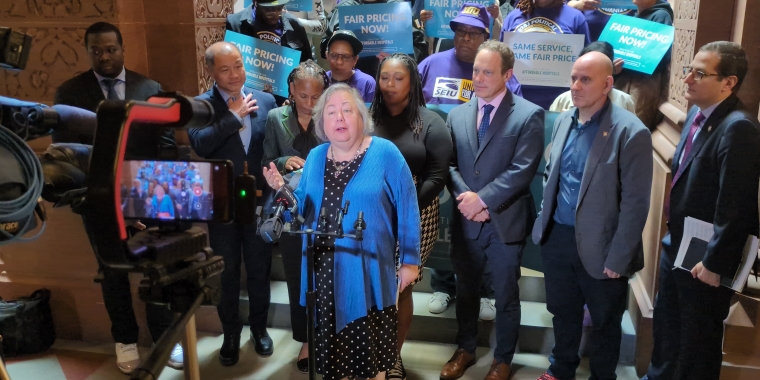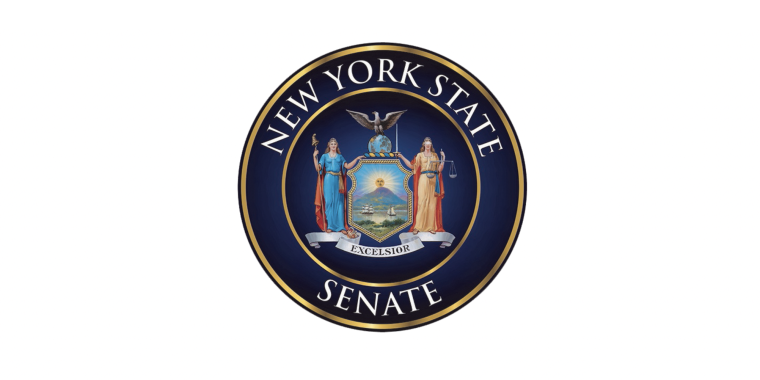
Testimony Before the New York City Rent Guidelines Board Regarding Proposed Rent Increases on June 12, 2007
Liz Krueger
July 15, 2010
My name is Liz Krueger and I represent the 26th Senate District, which includes the Upper East Side, East Midtown and Midtown areas of Manhattan. I want to thank you for providing me with this opportunity to testify on the range of proposed rent increases for rent stabilized tenants- anywhere from 2 to 4.5% for one-year leases and 4 to 7.5% for two year leases. Even if the rent increases ultimately approved are at the low end of the proposed ranges, I have many serious concerns about what this decision would mean for the more than one million low, moderate and middle-income rent stabilized residents of New York City who are already facing a crisis of affordability and tremendous cost of living increases.
I fear that rent increases of 4.5% and 7.5% will lead to further hardships, and even evictions, for tens of thousands of New York City’s families, many of whom are barely making their current rents. The effects of these increases on seniors, the disabled and other vulnerable New Yorkers on fixed incomes would be especially grave. New York City is facing a tremendous escalation in the loss of its rent regulated housing and is currently undergoing the largest loss of all different types of affordable housing seen in recent times. Between 2002 and 2005, NYC lost 44,135 regulated units in buildings constructed before 1947 to high rent vacancy decontrol and condo/co-op conversions. Over one third of the city’s subsidized apartments were lost between 1990 and 2006, with substantial losses in Mitchell-Lama housing. Over 26,000 units have already been lost, many of them being rentals. And the situation will only continue to get worse as a recent 2006 NYC Comptroller’s report has noted, that since 2004, more than 25,000 additional units have either withdrawn or filed a notice to withdraw from the program, including the huge complex of Starrett City, with over 6,000 units which also could be lost if it is sold under the current owner’s plan.
Rent stabilized housing is the only affordable housing resource left to most low and moderate-income tenants. However, once they have been priced out of their apartments, many rent stabilized tenants have few other options. Currently, the market for rentals and coops/condos is so strong that owners are able to ask for rents and prices well above what the median renter can afford – in every neighborhood of the city. According to the Rent Guidelines Board (RGB) RGB’s 2007 Housing Supply Report, the Attorney General’s Office has reported a 75.8% increase in the number of condominium or cooperative units plan accepted in 2006. In my district, most of the new developments being built are luxury condos and an increasing number of the conversions of what were once largely rent regulated building are these types of plans which are unaffordable to many of the remaining tenants.
I strongly encourage the board to reconsider its preliminary vote and to enact significantly lower guidelines. Such a decision would be entirely consistent with the legislative mandate and jurisdiction of the Rent Guidelines Board, which was established in 1969 to set rent guidelines that counteract the effects of an acute housing shortage. Free market conditions and the rules of supply and demand do not apply to the NYC rental market. This shortage still exists—according to the 2005 Housing and Vacancy Survey, the vacancy rate is 3.09%. A vacancy rate of less than 5% creates abnormal market conditions. The RGB’s mission is to construct or stimulate “normal” or “fair” rent levels in a market driven by chronic scarcity and instability. Below are the key justifications for my position, as well as suggestions about how the RGB can expand its role in preserving affordable housing in New York City.
Why Are Lower Guidelines Appropriate This Year?
While it is reasonable to expect tenants and landlords to share the burden of increased operating expenses, this burden must be shared equitably. It is unconscionable for building owners in one of the most profitable economic sectors of our economy to pass all of their expenses onto tenants who have a median household income under $32,000 and are facing numerous other regressive taxes and fees. Between 1996 and 2005, moderate income tenants, (those at 200% of the Federal Poverty Level, with incomes at approximately $34,340 for a family of three) saw their share of income going for rent increase from 34% to 40%. While poor renters face a tremendous rent burden, with over 39%of those living at or near the federal poverty level paying more than 55% of their income for rent each month. The median low income renter household in Manhattan spends 53% of its monthly income on rent
Owners of rent regulated buildings have done extremely well during the past decade – they have seen both their profits and the value of their properties rise exponentially, particularly those with properties in Manhattan. According to the RGB’s 2007 Income and Expense Study, owners’ Net Operating Income (the amount of income remaining after all operating and maintenance expenses have been paid) increased by 1.6% overall citywide, with Manhattan seeing an even greater increase of 5.5%. According to the 2007 Income and Affordability study, the median income for owners in 2004 was $65,000 so while owners incomes have been rising steadily, tenants have been losing ground. Between 2002 and 2005 stabilized rents rose by over 8% while incomes for stabilized tenants went down by 8.6% when adjusted for inflation to 2004 dollars. During the last 3 years, the median household income in Manhattan has fallen by 5.6% while the median contract rent has risen 10% when adjusted for inflation.
Building owners legitimately claim that their operating expenses have risen during the last year due to the rising property tax rates and the cost of insurance. However, the rent regulated real estate market continues to be one of the most consistently profitable investments in New York City. This sector of the NYC’s real estate market remains so strong that even after the recent rise in operating expenses, Crain’s New York Business described it on May 5th, 2003 as “one of the hottest segments of the New York real estate market…..The stock market is volatile, and the commercial real estate is too risky for many investors. Refinancing is cheap. Rent regulated buildings offer a consistent return.”
This year’s Price Index of Operating Costs (PIOC) must be understood in a larger historical context. The dramatic increase in Net Operating Income between 1989 and 2002 suggests that the RGB has historically overestimated owners’ operating and maintenance costs, and instituted guidelines higher than those which were required to enable owners to properly maintain their buildings and profit margins.
The RGB’s 2007 Mortgage Survey reveals that interest rates for new and refinanced multifamily mortgages continue to be low. Lower interest rates, combined with high levels of competition between lenders, have created extremely favorable conditions for owners of regulated buildings, and decreased the amount of revenue owners must allocate to debt service on their properties. This fact is not considered in the PIOC.
One of the most important factors the RGB must consider is whether owners of regulated properties have the necessary income to maintain their buildings. The overall condition of the city’s rent regulated housing stock is healthy and continues to improve; the RGB’s 2007 Income and Expense Study reveals that only 11% of all properties are distressed, down from 14% in 1990.
Landlords have many additional methods to increase rents to account for costs and be reimbursed for necessary repairs—such as MCIs, vacancy increases, luxury decontrol and individual apartment improvements.
Furthermore, owners of rent regulated units have the right to receive hardship increases if they do not receive a certain rate of return on their investments. The fact that so few hardship applications are filed each year reveals the overall health of the sector, as well as the reticence of owners to open their books to inspection as is required during the hardship application process.
RGB Should Adopt Proactive Provisos to Enforce the Rent Regulations Laws
The RGB can and should consider enacting several important provisos, which would language included in the guidelines that would not only encourage owners to maintain their buildings but also serve to enforce several important provisions in the rent regulation laws and provide greater fairness between owners and tenants.
A proviso that would greatly aid in enforcing the rent regulation would be barring the collection of rent increases when owners have not registered all of the rent stabilized units in their buildings with the NYS Division of Housing (DHCR) as is current required by law. This is a simple and equitable condition that would not only encourage owners to properly register their buildings; it would decrease instances of fraud and abuse of the four year rule, overcharging existing and new tenants and exploiting loopholes in the law regarding preferential rents.
To continue to maintain as many rent regulated units in safe and decent conditions, RGB should enact a proviso that would prohibit owners from collecting the guideline increase if there are five or more hazardous (either B or C) violations of record per unit. Owners should not be able to collect rent increases when they are not maintaining their units while tenants live in deplorable and unsafe conditions.
Larger Implications and Economic Context of RGB’s Decision
Section 26-510(b) of the Rent Stabilization Law requires the RGB to consider “relevant data from the current and projected cost of living indices” in its deliberations; the RGB members are also permitted to consider the effects of their decisions on the availability of affordable housing throughout the city. After being adjusted for inflation, median wages have decreased in many sectors. NYS continues to have one of the highest unemployment rates in the country—with the highest rates of unemployment being in the five boroughs of New York City. Unemployment rates increased during the early months in 2007. The NYC jobless rate was 5.3% in January and 5.1 in February, which was slightly higher than the 2006 rate of 4.9%.
There is a direct correlation between RGB increases with the loss of affordable housing as more units become subject to vacancy decontrol, and increased levels of homelessness. Approximately 13,974 rent-stabilized units were deregulated last year, more than 9,983 of these due to high rent/vacancy decontrol, going up by 8% from 9,272 in 2005. In 2006, an average of 32,430 people stayed in city homeless shelters each night; the number of families staying in shelters increased to 8,339, significantly higher than its levels in the 1980s and 1990s. The RGB’s proposed guidelines would exacerbate the already dire circumstances of New York’s low and moderate-income families.
The proposed guidelines would also have significantly deleterious effects on middle-income families. The preservation of affordable rent regulated units is essential to efforts to keep middle-class families in NYC and to the maintenance of healthy stable communities. If we truly want the city to maintain its vitality and diversity, we must do all can to ensure an effective rent protection system.
Other Important Roles for the RGB in Protecting Affordable Housing
The RGB has made significant contributions to the public understanding of housing issues by producing a wide range of empirical studies. This research role has made the RGB a key participant in the ongoing public conversation about the fairness and effectiveness of the rent stabilized system, and I encourage the Board to utilize this resource to the fullest extent possible.
The PIOC is an extremely imprecise and controversial measurement of owners’ income and expenses. The NYC RGB should have the ability to make decisions based on owners’ actual yearly data. The rent guidelines boards of Nassau, Westchester and Rockland counties, which have the power to subpoena owners’ revenue and income data, consistently pass significantly lower increases than the NYC board. Tenants in NYC should have the same right as tenants in Nassau, Westchester and Rockland counties to know that the increases on their apartments are based upon their landlords’ income and costs.
The RGB has the power to adopt resolutions with respect to the legislative design and administration of the rent stabilization laws. I strongly urge the RGB to pass a resolution calling upon the State Legislature to require NYC landlords to provide data directly to the RGB each year.
The RGB should also pass resolutions asking DHCR to keep more comprehensive data, to provide complete data to the Board and the public and to proactively investigate complaints of illegal deregulation of apartments, questionable MCI increases, and harassment charges.
Share this Article or Press Release
Newsroom
Go to NewsroomSenator Krueger's May 2025 Update
May 30, 2025

